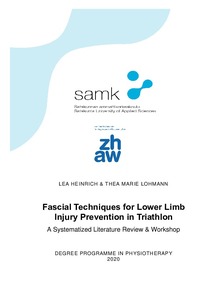Fascial Techniques for Lower Limb Injury Prevention in Triathlon : a Systematized Literature Review & Workshop
Heinrich, Lea; Lohmann, Thea Marie (2020)
Heinrich, Lea
Lohmann, Thea Marie
2020
Julkaisun pysyvä osoite on
https://urn.fi/URN:NBN:fi:amk-2020101821397
https://urn.fi/URN:NBN:fi:amk-2020101821397
Tiivistelmä
Background
Triathletes compete in swimming, running and cycling. Long training hours and competitions generate strain on the body and increase the risk of injuries. Especially overuse injuries are common amongst triathletes and can be traced back to fascia. As fascia techniques can improve the range of motion (ROM) of the lower extremity, incorporating those into the training regimen can have a positive impact on injury prevention.
Research Question for the Systematized Literature Review
What are the effects of fascia techniques on the lower extremity of the human musculoskeletal system concerning injury prevention for triathletes?
Objectives of the Workshop
The workshop synthesizes information in an attainable format. The results of the systematized literature review are linked with information about the role fascia training plays in preventing injuries in triathlon.
Method
A systematized literature review was conducted with two main studies, which were selected according to in- and exclusion criteria. On the basis of the systematized literature review, a workshop with fascia techniques for injury prevention, was implemented.
Results
The results of the systematized literature review suggest that fascia techniques can reduce the prevalence of injuries in triathlon, by increasing the ROM in the lower extremity. Foam rolling (FR) and Fascial Abrasion technique (FAT) lead to acute increases of the hip and knee ROM, while FR, static stretching (SS) and the combination of SS and FR acutely improve the passive ankle dorsiflexion ROM. The FAT technique and the combination of FR and SS are superior to the other techniques.
Conclusion
Using the fascia techniques FR, SS and FAT may be used for injury prevention, as they lead to an acute increase of the ROM in the lower extremity. Using FAT and the combination of FR with SS, is especially recommended.
Triathletes compete in swimming, running and cycling. Long training hours and competitions generate strain on the body and increase the risk of injuries. Especially overuse injuries are common amongst triathletes and can be traced back to fascia. As fascia techniques can improve the range of motion (ROM) of the lower extremity, incorporating those into the training regimen can have a positive impact on injury prevention.
Research Question for the Systematized Literature Review
What are the effects of fascia techniques on the lower extremity of the human musculoskeletal system concerning injury prevention for triathletes?
Objectives of the Workshop
The workshop synthesizes information in an attainable format. The results of the systematized literature review are linked with information about the role fascia training plays in preventing injuries in triathlon.
Method
A systematized literature review was conducted with two main studies, which were selected according to in- and exclusion criteria. On the basis of the systematized literature review, a workshop with fascia techniques for injury prevention, was implemented.
Results
The results of the systematized literature review suggest that fascia techniques can reduce the prevalence of injuries in triathlon, by increasing the ROM in the lower extremity. Foam rolling (FR) and Fascial Abrasion technique (FAT) lead to acute increases of the hip and knee ROM, while FR, static stretching (SS) and the combination of SS and FR acutely improve the passive ankle dorsiflexion ROM. The FAT technique and the combination of FR and SS are superior to the other techniques.
Conclusion
Using the fascia techniques FR, SS and FAT may be used for injury prevention, as they lead to an acute increase of the ROM in the lower extremity. Using FAT and the combination of FR with SS, is especially recommended.
